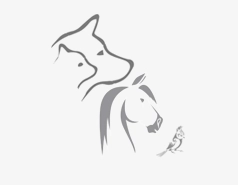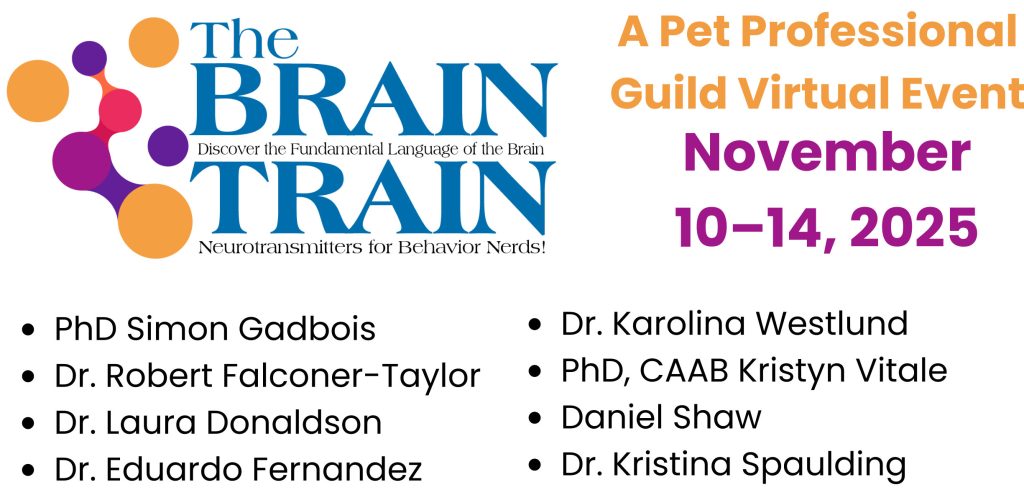Learning Theory
The Smartest Dog?
The other day, I got a good laugh reading the bumper sticker of the car in front of me: “My Dog Is Smarter Than Your Honor Student!” This got me wondering as we “pet-parents” often do, about how smart my own dogs are. By coincidence, I happened upon a newsletter from a local veterinarian’s blog listing the top seven most intelligent dog breeds (border collie, poodle, German Shepherd, golden retriever, Doberman, Shetland sheepdog, and Labrador retriever). Unfortunately my dogs were not on the list, but undeterred, I went to the American… Continued

Join Me at the Pet Professional Guild Force-Free Summit!
Presenting: TrickMeister Reinforcement Strategies for Success! I can’t believe how quickly the second Pet Professional Guild’s Force-Free Summit is approaching! It doesn’t seem like two minutes since we were in Tampa attending the first Summit in November, 2015! November, 2016 will soon be here and we will all be back in Tampa for the second round! I’m fortunate to be presenting at the Summit on a subject that I believe to be absolutely crucial to our pet clients’ well-being – reinforcement! My presentation and working LAB is entitled: TrickMeister Reinforcement… Continued
The Game Of Know, Not No!
Many years ago when I was first learning this “new” method called positive reinforcement training, even though my dog was learning in huge leaps to do all the behaviors I asked him to do, I had this nagging question: But how can I tell him when he does something wrong? Humans seem to be wired that way and are more apt to point out someone’s errors more often than looking for something correct. And unfortunately for our canine friends, we take the same punitive stance. This makes sense to some… Continued
Scent Tracking as Part of Your ABC
When consulting on canine behavior problems, you will be looking at your ABCs – Antecedent – Behaviour – Consequence – as part of your functional assessment. The immediate antecedents, such as direct environment, setting the dog off doing something the owner is not happy with, are often fairly easy to spot, although sometimes challenging to address. There are excellent protocols developed for that, such as BAT (Behaviour Adjustment Training, developed by Grisha Stewart), LAT (Look at That Training, developed by Leslie McDevitt, author of the book Control Unleashed) and Reactive aggressive… Continued
To Prompt or to Reinforce
Click – treat, click – treat, click – treat. As trainers, we all know what is going on here; someone is conditioning a clicker. But the lines can get blurred from here. First we click and treat until the animal alerts to the click. Then we use the click to indicate to the animal that they have done the thing we want and that they will, in all likelihood, get a treat. Before that, though, we use the treat to lure the animal to perform the behaviour we want. This… Continued
The Perfect Dog
I have the perfect dog. He doesn’t bark, “potty” in the house, chew on furniture, or do ANY undesirable dog behaviors. Perhaps you have one too; mine is called Fido, and he’s a big stuffed dog! Real dogs bark, dig in the yard, eliminate in the house, whine, chew on furniture and other delectable human artifacts. And they do this unless the dog-guardian knows how to prevent the behavior from occurring while showing the dog what behaviors they’d like him to do. Unfortunately for a lot of our dogs, their… Continued
Force-Free: Are You Getting the Correct Message Across?
Recently I learned of a trainer whose specialty is working with hunting dogs. For the purpose of this blog I will call him Bob, mostly because I like that name, and I like the trainer. The majority of hunting dog trainers use traditional methods, but several years ago Bob gave up the methods he was most familiar with and formally studied modern methods based on reinforcing desired behaviors. Today Bob identifies himself as a “positive” trainer meaning that he does not use a shock/choke/pronged collar and does not impose fear,… Continued

Teaching the TrickMeister Way!
How important is it to teach your canine companion what you would like them to do? I believe it is extremely important but what is even more essential is that you teach in a way that doesn’t cause any stress; that you teach in a way that is fun for both teacher and student; that you teach in such a way that each ‘lesson’ is easy to understand; that you teach in a way that not only encourages learning but enhances it and that you teach in a way that… Continued
Just Say No to Saying No
“Can I say no to my dog?” is a question I often hear from new clients. My short answer is “Yes, you can use any word or sound you please in training.” Pavlov proved that long ago. The problem is in the way dog owners use “no” and whether it leads them closer to success. Owners usually approach dog training as a way to stop undesirable behavior and saying “no” seems a logical choice…to a human being. I begin reframing their goal by suggesting “Let’s think about what you want… Continued
I Only Have Eyes For You!
One of my specialities is doing in-home training so that the human gets trained and then I highly recommend taking Fido to a group class to practice the new skills in a more distracting environment. And for puppies, this is very important as it will help with the socialization process of playing with other puppies off leash, meeting new humans and of course teaching the human how to work with Pup around more distractions. But working in more distracting environments is NOT the same as when you are working at… Continued
Treats or Bingos?
Traditionally, tidbits given to dogs outside their regular meals are labeled ‘treats’. Pet shops sell ‘treats’ and we traditionally refer to any food the dog gets by hand for doing nothing as a ‘treat’. I feel this ‘treat’ word can sometimes get in the way of converting people who have ‘had dogs all their lives’ to positive, reward-based training methods. They commonly ‘don’t believe in giving their dogs treats all the time’ and for this reason refuse to carry food rewards around with them. The Oxford Dictionary defines ‘to treat’ as… Continued
The Shocking Truth
With recent events in Scotland regarding so called e-collars (the ‘e’ stands for electronic), the debate has been heating up. I thought I would take this opportunity to air a few suggestions to some of the statements that are being made. There appears to be some serious misconceptions and incorrect information surrounding e-collars that I would like to address in one swoop, here is an excellent platform to do just that. I wanted to start with a deeply scientific article about using e-collars but you know what, the people that will read that… Continued
Taming the Dreaded Oreckosaurus Rex
Some dogs run and hide at first sight of the vacuum cleaner or unleash a barrage of barking, lunging and biting at the dreadful thing. Others quickly identify the vacuum cleaner’s lair and the fear response begins as soon as the person reaches to open the closet door. Cleaning house soon becomes stressful for dog and owner alike. Imagine what a vacuum cleaner appears like from a canine perspective. Dogs are conscious of height, size and elevation as it relates to their sense of security. With more sensitive hearing than… Continued
A Freddie Moment
Freddie passed away on October 4, 2014. Not a day goes by that I don’t think of him and all that he meant to me in his brief life. He changed my world significantly since our first meeting at the adoption fair, and without him, I never would have discovered the joy in helping other people and their special canine companions. But rather than be maudlin, I’d like to share an excerpt from an article I wrote for a magazine years ago, highlighting “volunteer activities with your dog.” While unpacking… Continued
Confession of a Professional Dog Trainer
My name is Daniel H. Antolec. I am a professional certified force-free trainer…and I own a shock collar. Not only do I own a shock collar, but it is among my most prized possessions and is proudly displayed in my library of 45 books and 25 DVDs on training and behavior. You see, once upon a time I met a little dog named Pete and his owner, Penelope. I changed their names for this blog but the story is factual. Pete was six weeks old when Penelope obtained him. He… Continued
Shaping without a Clicker
Most trainers agree that if there is one thing that the tool called a clicker is useful for in particular, it is for shaping behavior. Shaping consists of marking and reinforcing successive approximations towards a goal behavior. When shaping, the trainer can find herself needing to mark very small or quick movements indeed, sometimes just a weight shift or a breath. When that is the case, the behavior is usually long over by the time one can get food or a toy to the animal. A clicker or other marker can form a “bridge” between the… Continued

Misconceptions of Counterconditioning Leash Reactive Dogs
Misconception #1 – Feeding a dog when they are barking or fearful reinforces the fear. Absolutely not true. You can only cause more fear by implementing more fear or pain. Fear trumps food, so if the dog is taking the food, they are not that fearful. The food is not the focus of the on leash event; the impending, approaching or sudden stimulus is the focus. This is not like a food bowl that gets kicked repeatedly or a dog that is attacked by other dogs over food, and the… Continued
An Open Letter to Canine Research Scientists
PPG Member Linda Michaels MA PCT-A calls on canine research scientists to lead the way on the ethical treatment of companion animals and take a stand against shock collars. It would require a long list to delineate the benefits of companion animal canine research conferences and live streams. Admirably, these conference bring canine researchers into the mainstream of the canine applied practices fields, i.e., dog training. Many pet parents and trainers take careful note of scientific positions and plan to incorporate the lessons-learned into their practice. The researchers benefit in… Continued
The Nose Knows
A well-known test devised in 1970 by psychologist Gordon Gallup Jr. is used to determine whether an animal recognizes himself in a mirror. This “mirror test” is widely regarded as the “gold standard” for determining whether an animal is self-aware, that is, recognizes himself as a distinct individual and has a concept of self. This test may very well do that — sometimes, for some animals. Chimpanzees and some other primates pass easily; elephants and dolphins also pass. Most dogs do not, and, for many scientists, this is held up… Continued
Very Clear on the Concept
Jana started learning concepts and putting things into categories way back when she was a puppy, before Chaser was even born. Chaser is the most famous “categorizing” dog; she has learned the names of well over 1,000 items and can group them into the right categories: toys, balls, Frisbees, etc. In addition, she has demonstrated an understanding of grammar, correctly taking one item to another, for example. She also can watch, remember, and imitate complex strings of behaviors. Chaser’s story is told in Chaser: Unlocking the Genius of the Dog Who… Continued
The Far Side Of Behavior Solutions
One of my favorite Gary Larson, Far Side cartoons, is a drawing of a girl reading a book about equine medicine with the caption, “Doreen breezes through her first semester of veterinary school.” The page shows a long list of possible horse ailments and only one antidote…shoot him! Unfortunately this is how a lot of people deal with their dog’s behavioral issues. And while symbolically shooting the dog may seem like the right thing to do, after all the dog is “behaving badly” and therefore needs to be taught a lesson;… Continued
Are ‘Free-Shaped’ Dogs Better Problem Solvers?
A look at the criticisms of lure-reward training by Carmen LeBlanc MS ACAAB CPDT. First published in BARKS from the Guild, April 2014, pp. 12-18 Most professional dog trainers have heard about criticisms of lure-reward training in recent years. These criticisms have been made along with enthusiastic claims about the superiority of free-shaped (unprompted, trial-and-error) clicker training. Those of us who use free-shaping understand the enthusiasm. It is challenging and exciting to communicate with dogs in such a free-form way, developing a new behavior one small increment at a time.… Continued
What Dog Training Really Taught Me
Image credit: Yvette Van Veen of Awesome Dogs. Please see full credit and sharing info at the bottom of the post. One of Many Examples This reinforcement/punishment combo is very common and easy to fall into, because of ignorance about how learning works, but also because of the unwillingness of humans to change their own behavior even when they might know better. It becomes the norm in many dogs’ lives. Here is but one example. It is a standard recommendation in traditional obedience training that when your dog pulls out of… Continued
May Your Bowl Always Be More Than Half-Full
Can dogs be optimists? Pessimists? Many people see dogs as natural optimists. After all, dogs are very loving and amazingly forgiving of human foibles (and worse — just look at all the mistreated dogs who still love humans). Many dogs greet every stranger as a new best friend. And some dogs are sure that a car ride means fun for dogs! Cali is one of those naturally sunny, cheerful, affectionate optimists, as I wrote recently on my Thinking Dog Blog. Her mission in life is to greet every single human on… Continued
« Previous 1 2 3 4 5 6 Next »

